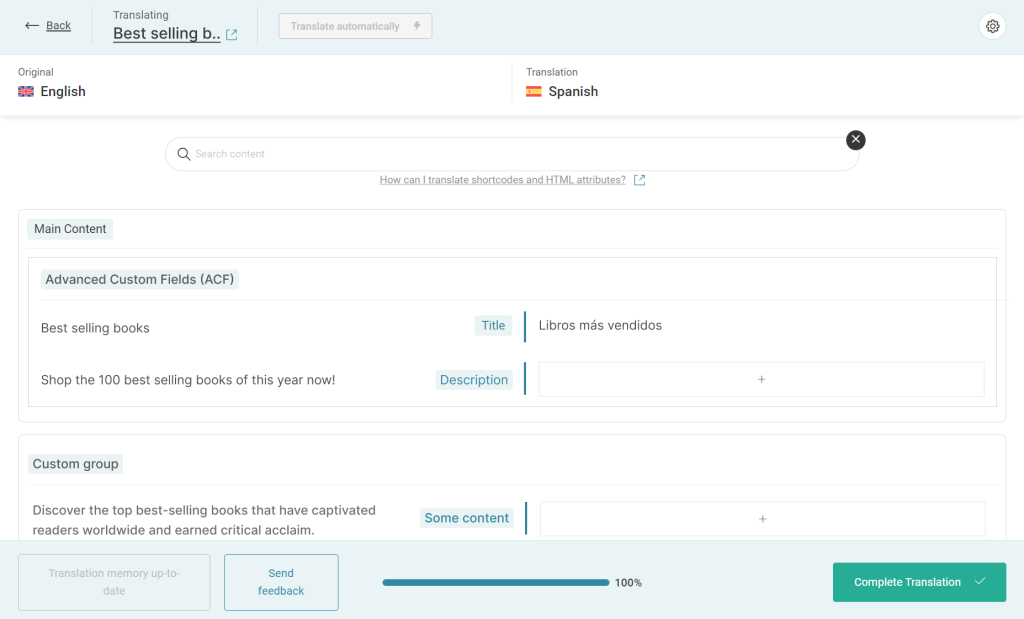Learn how to define translation settings for custom fields using the wpml-config.xml file. Set translation options like translate and copy, and insert additional attributes.
Setting Translation Options for Custom Fields
WPML provides four translation options for custom fields:
| Action | Description | Visible in ATE? |
| Translate | Enables the custom field value for translation | Yes |
| Copy | Copies the custom field value from the default to secondary language while keeping both in sync | No |
| Copy once | Copies the custom field value from the default to secondary language without keeping both in sync | No |
| Ignore | Avoids copying the custom field value to secondary language | No |
<wpml-config>
<custom-fields>
<custom-field action="copy">quantity</custom-field>
<custom-field action="translate">custom-title</custom-field>
<custom-field action="copy">weight</custom-field>
<custom-field action="copy-once">bg-color</custom-field>
<custom-field action="translate">custom-description</custom-field>
<custom-field action="ignore">date-added</custom-field>
</custom-fields>
</wpml-config>
Adding Attributes for Custom Fields
Label and Group Attributes
WPML lets you add attributes that appear in the Advanced Translation Editor. This includes:
- style – display single line (line), text area (textarea), or WYSIWYG (visual)
- label – displays label next to the field
- group – specifies what group the custom field belongs to. When a field is in a group:
- The field is removed from the custom field section
- The field is added to the related group’s section
<wpml-config>
<custom-fields>
<custom-field action="translate" style="line" label="Title">custom-title</custom-field>
<custom-field action="translate" style="textarea" label="Description">custom-description</custom-field>
<custom-field action="translate" style="visual" label="Some content" group="Custom group">custom-wysiwyg</custom-field>
</custom-fields>
</wpml-config>
Here’s what these attributes will look like in the Advanced Translation Editor:

Encode Attribute
You can also add optional encode attributes to change the encoding from the default value (no encoding). Encoding attribute accepts the following values:
- json
- base64
- urlencode
If you want to use multiple encodings, separate the values with a comma:
<wpml-config>
<custom-fields>
<custom-field action="translate" encoding="json,base64">keywords</custom-field>
</custom-fields>
</wpml-config>
Translate Link Attribute
If your custom field contains a link, you can use the translate_link_target attribute to force WPML to check and adjust links in the custom field.
<wpml-config>
<custom-fields>
<custom-field action="translate" translate_link_target="1">name_of_the_acf_field</custom-field>
</custom-fields>
</wpml-config>
WPML translates all sub-keys in custom fields by default. To bypass this, specify which sub-keys should be translated.
<wpml-config>
<custom-fields>
<custom-field action="translate">with_attributes</custom-field>
<custom-field action="translate">with_deep_attributes</custom-field>
<custom-field action="translate">no_attributes</custom-field>
</custom-fields>
<custom-fields-texts>
<key name="with_attributes">
<key name="attribute1" />
<key name="attribute2" />
</key>
<key name="with_deep_attributes">
<key name="attribute1" />
<key name="attribute2">
<key name="level1">
<key name="level2">
</key>
</key>
</key>
</key>
</custom-fields-texts>
</wpml-config>
Wildcards
You can also use wildcards the same way as they’re used for Admin texts:
- Match all subfields starting with title- using code:
<key name="title-*" /> - Match all subfields and is generally used to match an array index using code:
<key name="*" /> - To get
[{"title":"First title"},{"title":"Second title"}]use code
<wpml-config>
<custom-fields-texts>
<key name="key-name">
<key name="*">
<key name="title" />
</key>
</key>
</custom-fields-texts>
</wpml-config>
Additional Resources
To learn more about the wpml-config.xml file, visit the Language Configuration Files guide.
For customizing other elements using the wpml-config.xml file, visit our additional guides:
- Translate Custom Shortcodes with WPML
- Register Page Builder Content for Translation
- Register Custom Page Builder Widgets for Translation
- Register Custom Terms, Types & Taxonomies as Translatable
- Make Custom Gutenberg Blocks Translatable
- Translate Texts that Theme and Plugins Save in wp_options
- Customize WPML Language Switcher Using WPML Configuration File
